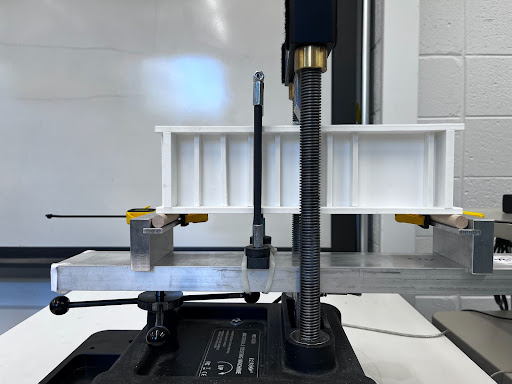Civil engineering student Eleni Retzepis is building your next bridge
What does a bunny have in common with steel plates for structural engineering? Models of both can be made at the Princeton University Library (PUL) Makerspace.
Eleni Retzepis, a junior studying Civil and Environmental Engineering, has become a mainstay in the Library’s Makerspace. Occasionally, she’s making personal projects, like a bunny to give to a friend for her birthday. On other days she’s helping visitors make sense of the tools in the space, such as the 3D printers and sticker maker.

Eleni Retzepis stands in front of one of the PUL Makerspace’s 3D printers. Photo credit: Brandon Johnson
Still, on other days, Retzepis uses the Makerspace as a researcher, 3D printing models of innovative structural steel plate girders that – she hopes – will influence and innovate the way engineers build bridges.
During the summer of 2022, Retzepis participated in Princeton University’s ReMatch+ program, which builds research collaborations between undergraduate students, graduate students, and graduate and postdoctoral researchers from across campus. One event encouraged participants to visit the PUL Makerspace, where Retzepis quickly found comfort.
“At first, I experimented with the button machine, 3D scanner, 3D printers, and the sticker maker,” Retzepis recalled. “I came back and got 3D printer and sticker certified right away.”
As she spent more time in the Makerspace, Retzepis, along with her mentor, Parfait Masungi, began brainstorming how they might use the space’s tools for their project on bridge plate girders. Retzepis and Masungi were trying to devise a creative approach to design and enhance steel plate girders used as structural supports to overcome failures related to buckling.
“An alternative to flat girders is corrugated plates,” Retzepis explained. “The problem with those is that they are very difficult to manufacture and are very expensive.”
Thus, Retzepis and Masungi embarked on testing Low-Frequency Sinusoidal (LFS) plates. The design, which is based on a sine wave, offers the structural benefits of a corrugated plate but over a relatively larger wavelength, making them easier to manufacture. After designing the plates in the software ABAQUS, Retzepis made multiple visits to the PUL Makerspace to 3D print the designs.
“These plates were about 20-hour projects,” Retzepis said, noting the Makerspace’s limit of 12 hours per print job. “We also had to consider mesh and infill density – how dense the 3D prints come out – and find a balance between the engineering piece of this and respecting the rules of fabrication within the Makerspace.”
Through her testing and printing, which took about three weeks, Retzepis and Masungi developed a 3D-printed LFS plate girder design that could handle more than 500 pounds. “We found that the higher the frequency of the test section of the plate, the greater the force it was able to support,” Retzepis explained. “A frequency of 2.5 was able to support 500 pounds, whereas a frequency of five supported almost 700 pounds.”

One of the 3D printed girders being tested for the force it can withstand. Photo Credit: Eleni Retzepis.
While she is taking a break from designing model plate girders to focus on her classes, Retzepis is already considering future projects. In addition to gifts for family and friends, she knows that the project and Makerspace could play a role in her senior thesis. And, as a Makerspace circulation assistant, she’ll stay busy helping others bring their ideas to life.
“Don’t be scared to walk into the Makerspace and ask questions,” Retzepis advised. “Sometimes, as a woman in engineering, it’s kind of intimidating to go into places like this, if you didn’t grow up with tools or weren’t exposed to them. It’s nice to come in here and play around and learn things as you go.”
To learn more available tools, visit the PUL Makerspace Website.
Published on Dec. 7, 2022
Written by Brandon Johnson, Communications Specialist
Media Contact: Barbara Valenza, Director of Library Communications
Newsletter
Subscribe to Princeton University Library’s e-newsletter for the latest updates on teaching and research support, collections, resources, and services.
